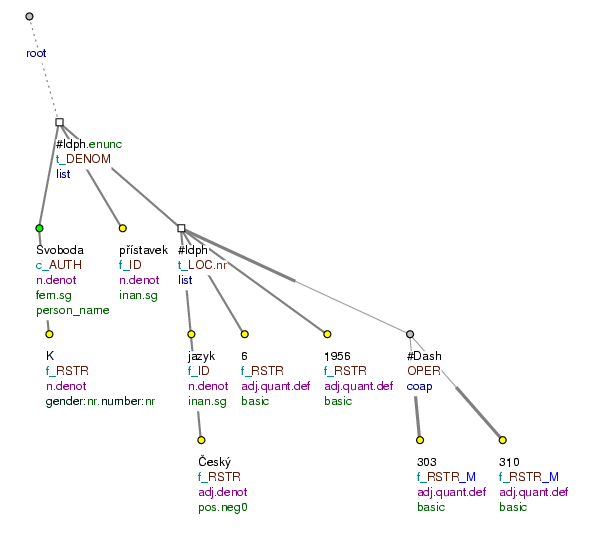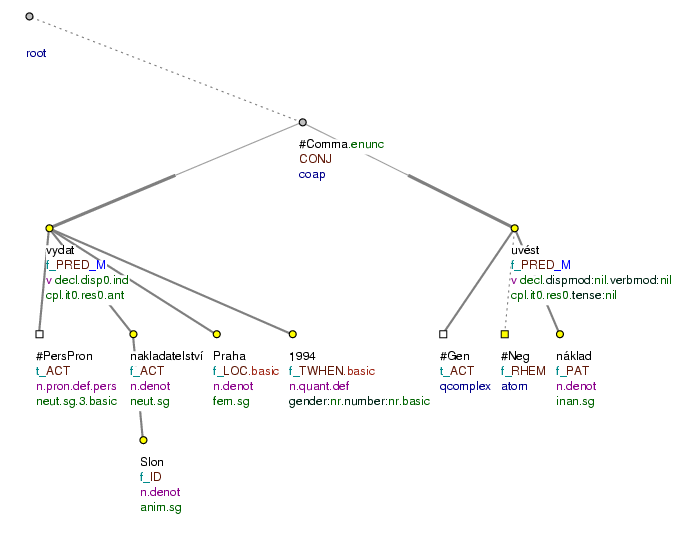Independent bibliographical data is represented according to the following rules:
-
book, monograph:
-
the effective root of the construction is a newly established node with the t-lemma substitute
#Idphand with the functorDENOM. -
the effective root of the title of the work is assigned the functor
IDand is dependent on the newly established node with the t-lemma#Idph. -
the nodes (effective roots) representing items which are components of the bibliographical data (author, publisher, year and place of publication) are also dependent on the newly established node with the t-lemma
#Idph. -
the node for the author of the work is assigned the functor
AUTH. The nodes for the rest of the bibliographical data are represented with the functorRSTR.
Examples and model trees:
Němcová: Babička, Albatros, Praha, 1974. (=Němcová: Grandma, Albatros, Prague, 1974.) Fig. 8.242
J.Keller P.Mareš: Nezaměstnanost jako problém. (=J.Keller P.Mareš: The unemployment problem.)
-
-
article in a journal or anthology:
-
the effective root of the construction is a newly established node with the representative t-lemma
#Idphand the functorDENOM. -
the effective root of the title of the article is assigned the functor
IDand is dependent on the newly established node with the t-lemma#Idph. -
All the remaining components of the bibliographical data (the author of the article and the anthology or journal containing the article quoted) are also dependent on the newly established node with the t-lemma
#Idphand with the functorDENOM. -
the node (effective root) representing the author of the work is dependent on the newly established node with the t-lemma
#Idphand is assigned the functorAUTH. -
the title of an anthology or journal is again represented by a newly created node with the t-lemma
#Idph, which acquires the functorLOC(If it occurs, the word In is not represented in the tectogrammatical tree by any node (it is represented as a preposition; see Section 17, "Prepositions and subordinating conjunctions"). -
the effective root of the title of a journal or anthology is assigned the functor
IDand is dependent on the newly established node with the t-lemma#Idphand the functorLOC. -
the nodes (effective roots) representing items which are components of the bibliographical data of an anthology or journal (editor, publisher, year and place of publication) are also dependent on the newly established node with the t-lemma
#Idphand the functorLOC. -
the node for the editor of an anthology is assigned the functor
AUTH. The nodes for the rest of the bibliographical data are represented with the functorRSTR.
Example and model tree:
Svoboda, K.: O přístavku. In: Český jazyk. 6, 1956, 303-310. (=Svoboda, K.: On apposition. In: Český jazyk (=Czech Language), 6, 1956, 303-310.) Fig. 8.243
-
Where bibliographical data is incorporated in a clause, a distinction is made on the grounds of presence or absence of morphology. In appropriate (syntactically incorporated) cases, nodes for individual bibliographical data are assigned an appropriate functor according to their location in the tectogrammatical tree; nodes (effective roots) for data without morphology (nominative keywords) are represented as syntactically non-incorporated parenthesis (see Section 7, "Parenthesis").
Examples and model trees:
Vydalo nakladatelství Slon, Praha, 1994, 151 stran, náklad neuveden. (=Published by Slon, Praha, 1994, 151 pages, number of copies not stated.) Fig. 8.244
Vydalo nakladatelství Slon, v Praze, 1994, náklad neuveden. (=Published by Slon, Prague, 1994, number of copies not stated.) Fig. 8.245
Figure 8.242. Bibliographical data

Němcová: Babička , Albatros, Praha, 1974. (=lit. Němcová: Grandma, Albatros, Prague, 1974)
Figure 8.243. Bibliographical data

Svoboda, K.: O přístavku. In: Český jazyk. (=Czech Language.) 6, 1956, 303 - 310. (=lit. Svoboda, K.: On apposition. In: Český jazyk (=Czech Language), 6, 1956, 303-310.)

